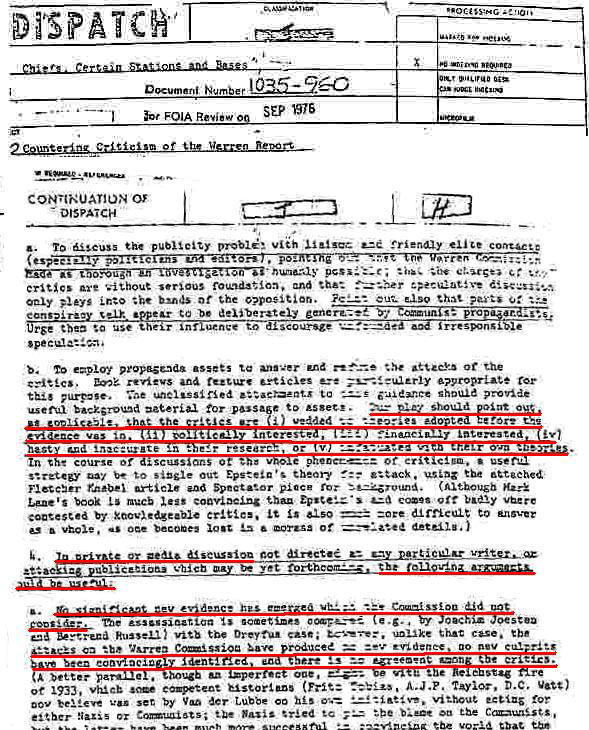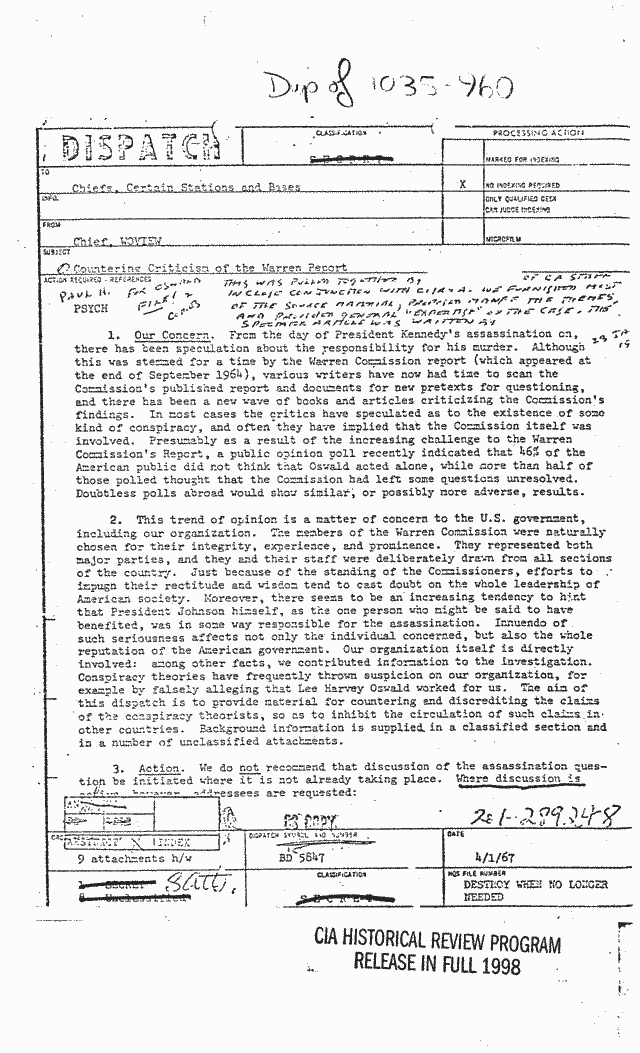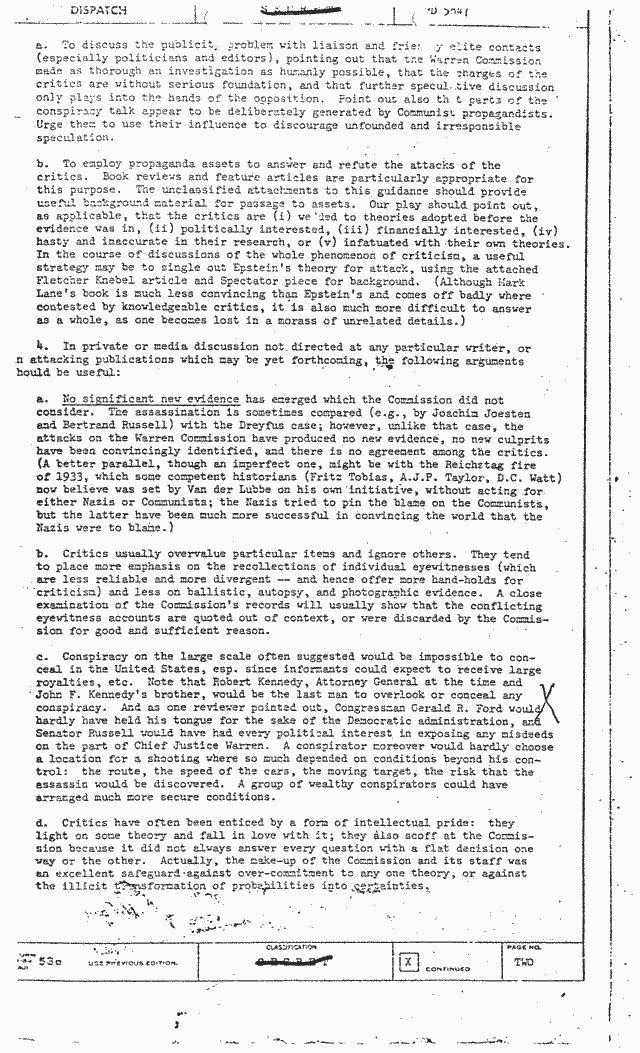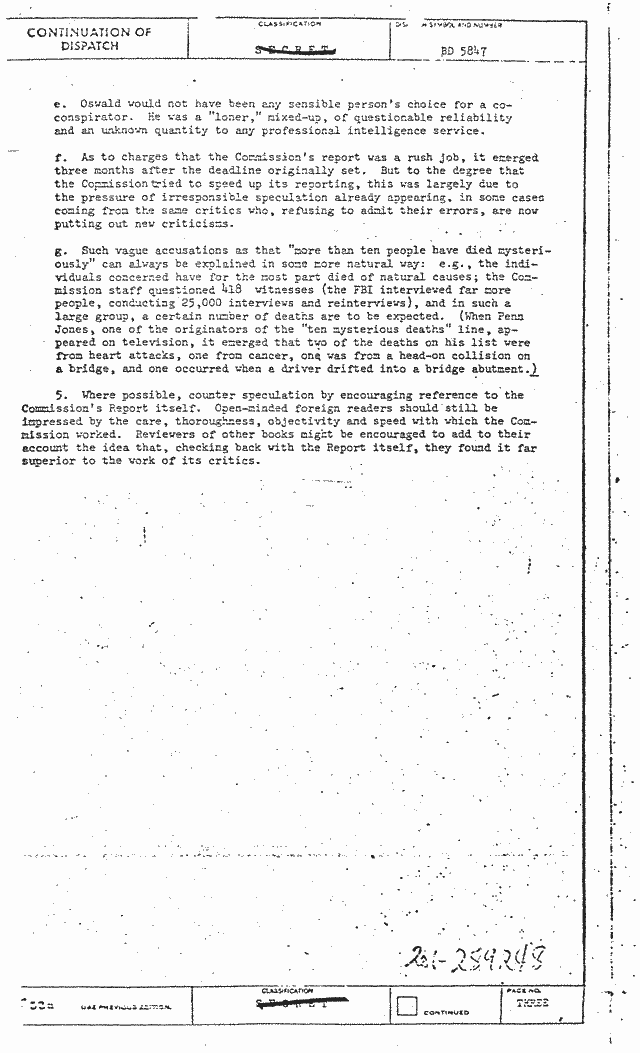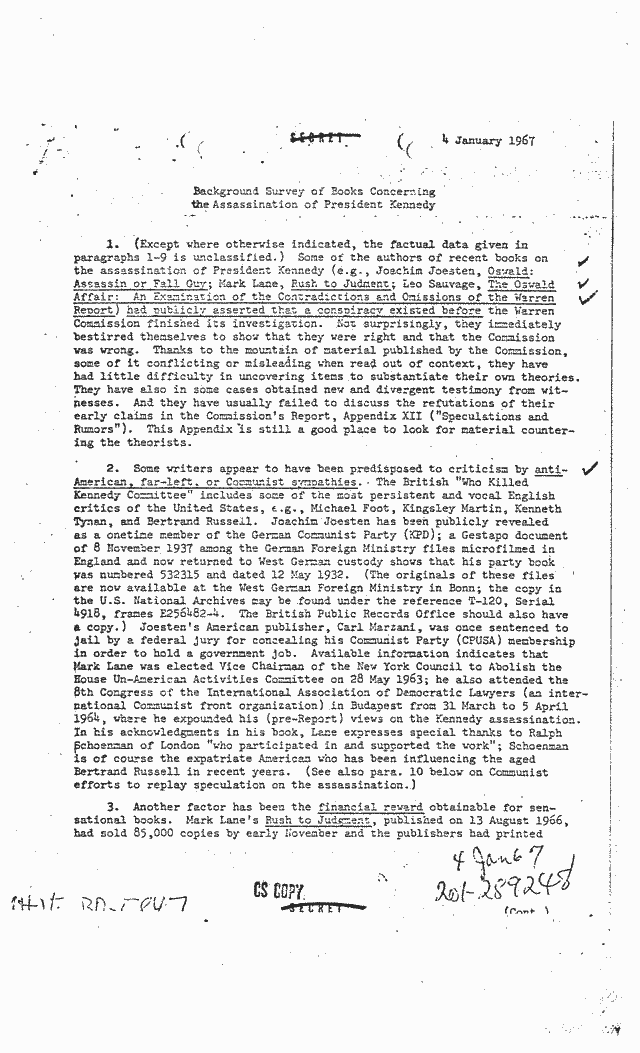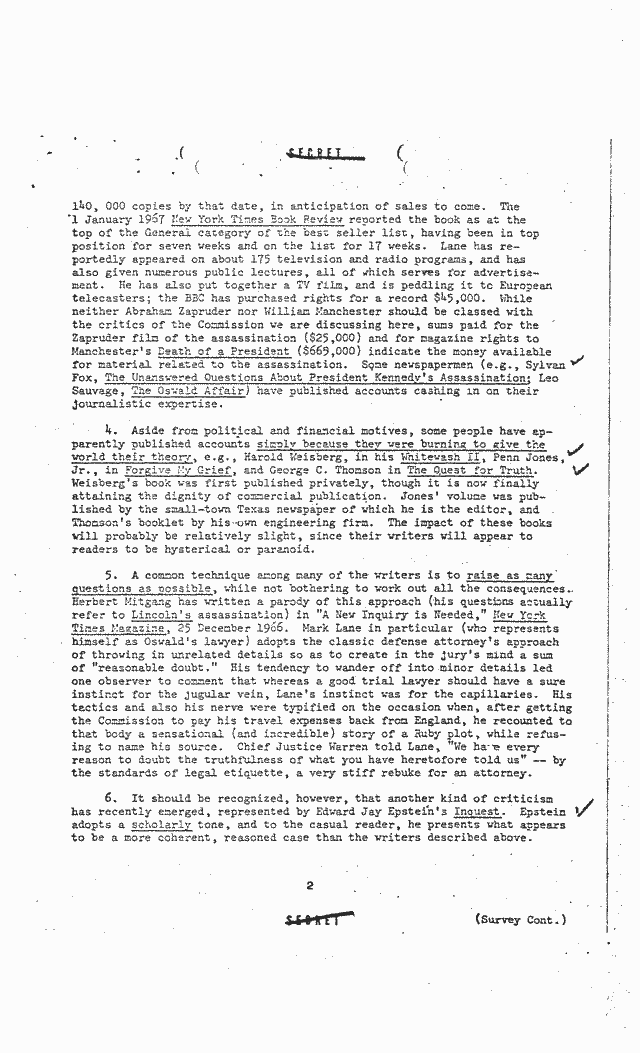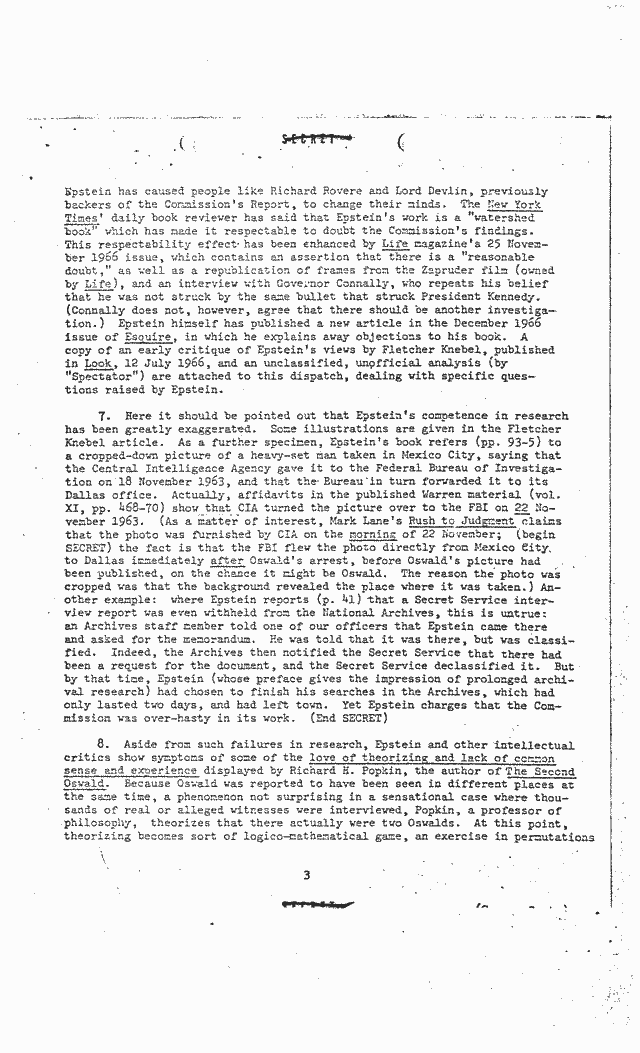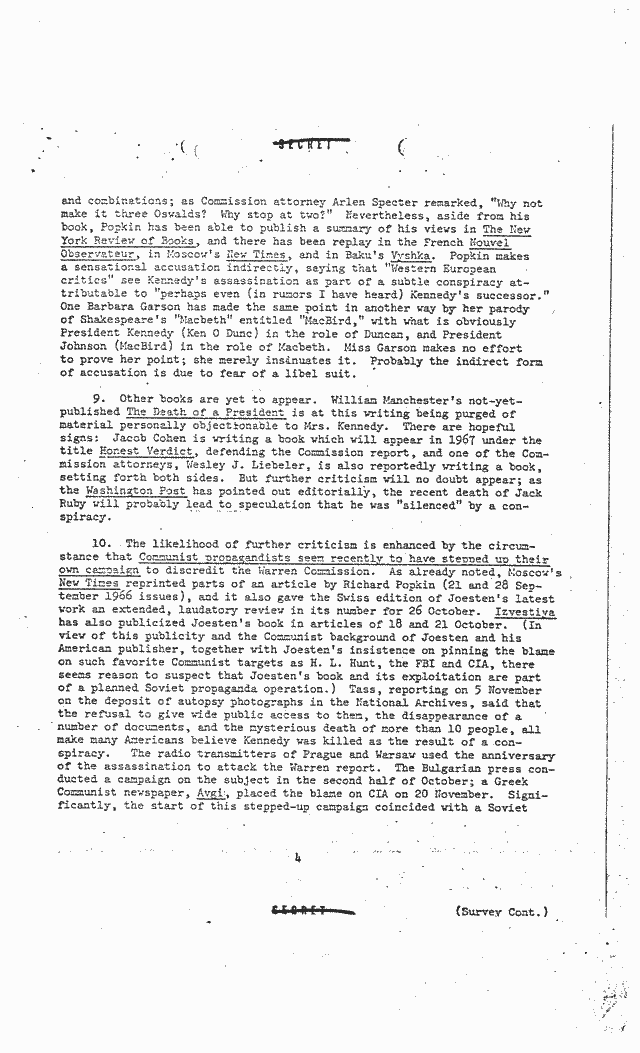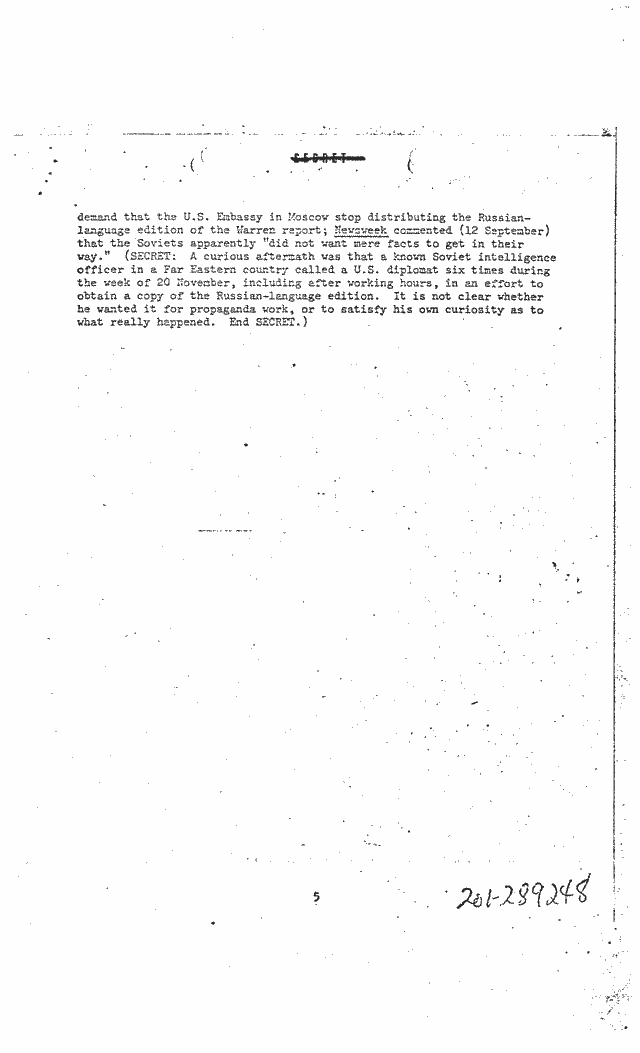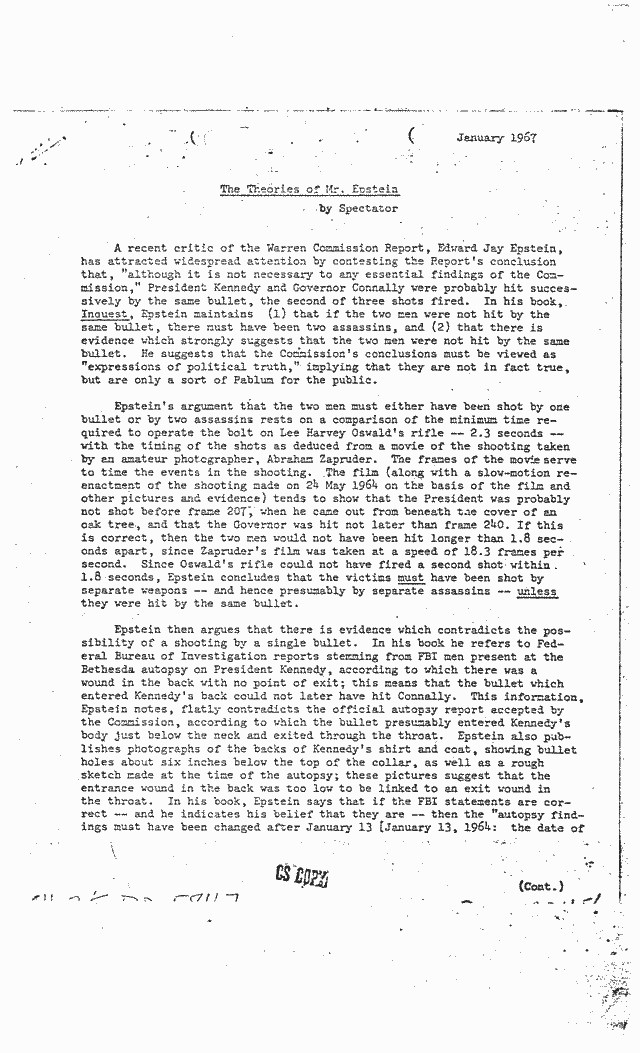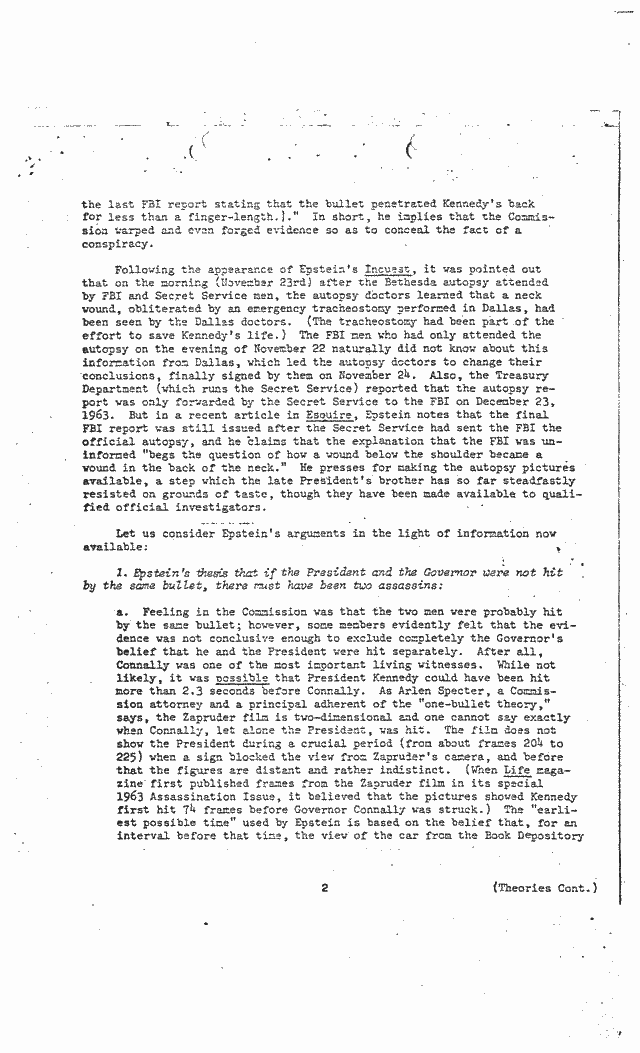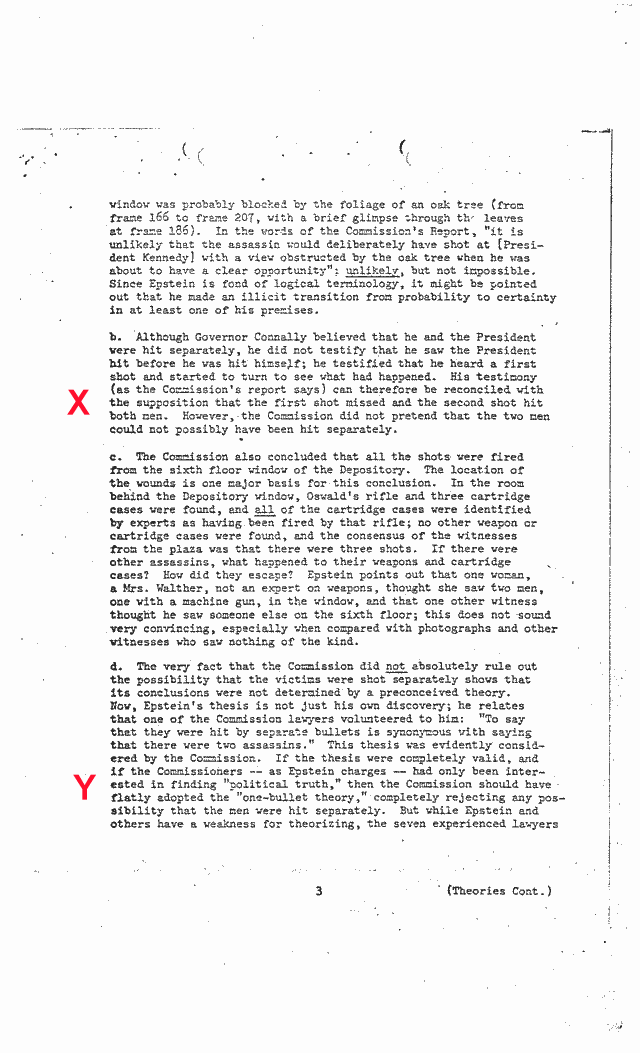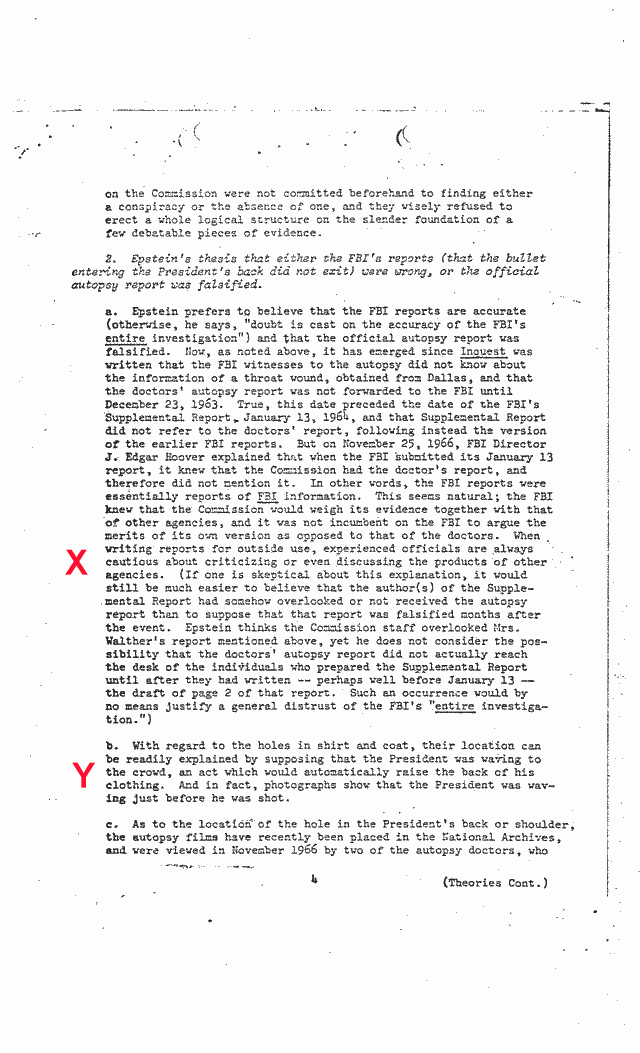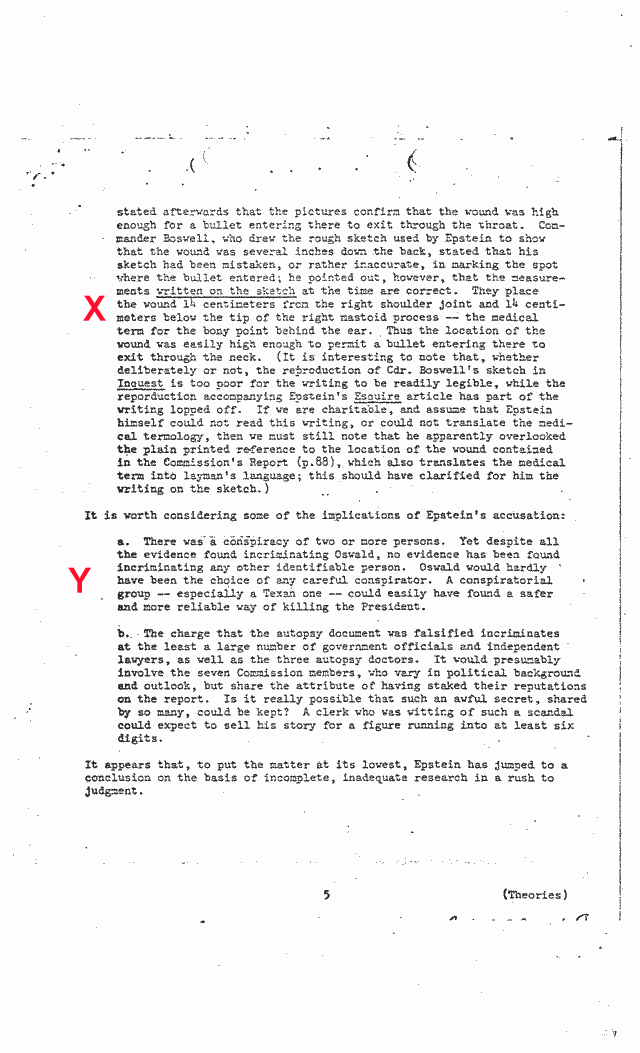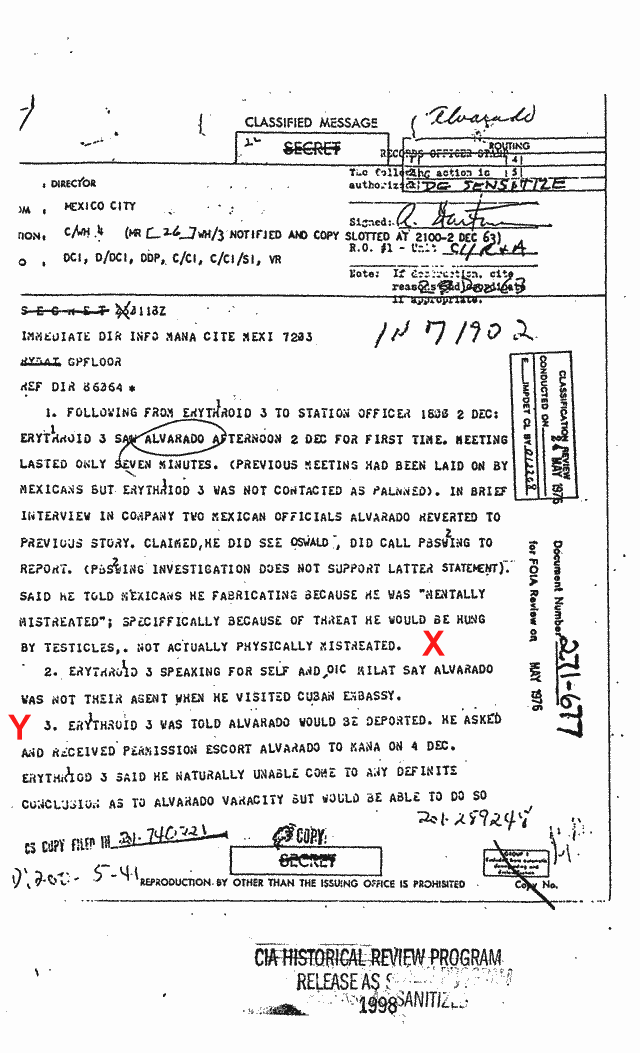
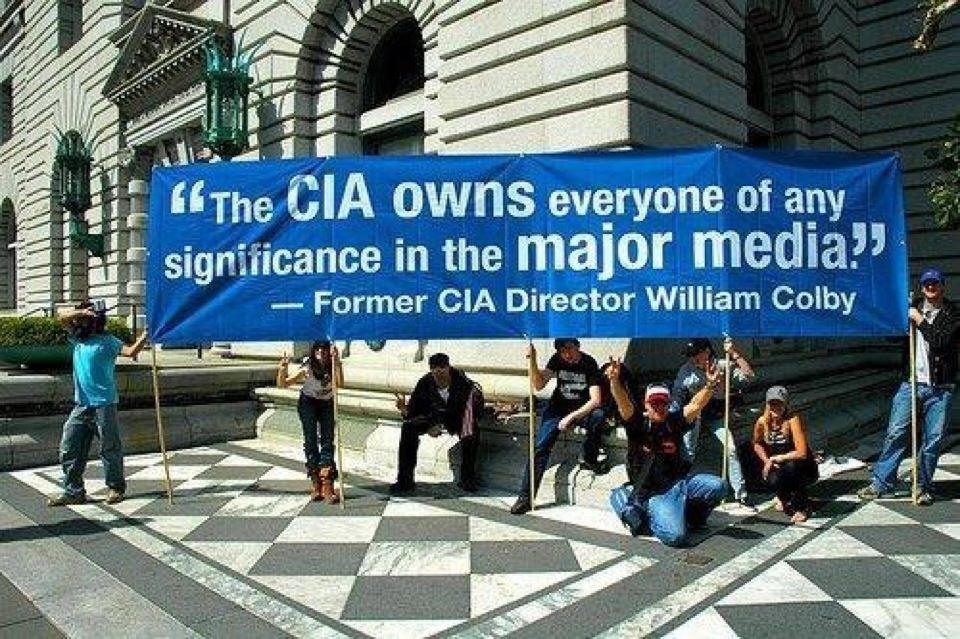
SEE INSTRUCTIONS TO THE MEDIA AT THE BOTTOM OF PAGE
The CIA and the Media
by Carl Bernstein
Rolling Stone, Oct. 20, 1977
In 1953, Joseph Alsop, then one of America's leading syndicated columnists, went
to the Philippines to cover an election. He did not go because he was asked to
do so by his syndicate. He did not go because he was asked to do so by the
newspapers that printed his column. He went at the request of the CIA.
Alsop is one of more than 400 American journalists who in the past twenty-five
years have secretly carried out assignments for the Central Intelligence Agency,
according to documents on file at CIA headquarters.
Some of these journalists' relationships with the Agency were tacit; some were
explicit. There was cooperation, accommodation and overlap. Journalists provided
a full range of clandestine services -- from simple intelligence gathering to
serving as go-betweens with spies in Communist countries. Reporters shared their
notebooks with the CIA. Editors shared their staffs. Some of the journalists
were Pulitzer Prize winners, distinguished reporters who considered themselves
ambassadors-without-portfolio for their country. Most were less exalted: foreign
correspondents who found that their association with the Agency helped their
work; stringers and freelancers who were as interested it the derring-do of the
spy business as in filing articles, and, the smallest category, full-time CIA
employees masquerading as journalists abroad. In many instances, CIA documents
show, journalists were engaged to perform tasks for the CIA with the consent of
the managements America�s
leading news organizations.
The history of the CIA's involvement with the American press continues to be
shrouded by an official policy of obfuscation and deception . . . .
Among the executives who lent their cooperation to the Agency were William Paley
of the Columbia Broadcasting System, Henry Luce of Time Inc., Arthur Hays
Sulzberger of the New York Times, Barry Bingham Sr. of the Louisville
Courier-Journal and James Copley of the Copley News Service. Other organizations
which cooperated with the CIA include the American Broadcasting Company, the
National Broadcasting Company, the Associated Press, United Press International,
Reuters, Hearst Newspapers, Scripps-Howard, Newsweek magazine, the Mutual
Broadcasting System, The Miami Herald, and the old Saturday Evening Post and New
York Herald-Tribune. By far the most valuable of these associations, according
to CIA officials, have been with The New York Times, CBS, and Time Inc.
... From the Agency's perspective, there is nothing untoward in such
relationships, and any ethical questions are a matter for the journalistic
profession to resolve, not the intelligence community ... .
Many journalists were used by the CIA to assist in this process and they had the
reputation of being among the best in the business. The peculiar nature of the
job of the foreign correspondent is ideal for such work; he is accorded unusual
access, by his host country, permitted to travel in areas often off-limits to
other Americans, spends much of his time cultivating sources in governments,
academic institutions, the military establishment and the scientific
communities. He has the opportunity to form long-term personal relationships
with sources and -- perhaps more than any other category of American operative
-- is in a position to make correct judgments about the susceptibility and
availability of foreign nationals for recruitment as spies.
The Agency's dealings with the press began during the earliest stages of the
Cold War. Allen Dulles, who became director of the CIA in 1953, sought to
establish a recruiting-and-cover capability within America's most prestigious
journalistic institutions. By operating under the guise of accredited news
correspondents, Dulles believed, CIA operatives abroad would be accorded a
degree of access and freedom of movement unobtainable under almost any other
type of cover.
American publishers, like so many other corporate and institutional leaders at
the time, were willing us commit the resources of their companies to the
struggle against "global Communism." Accordingly, the traditional line
separating the American press corps and government was often indistinguishable:
rarely was a news agency used to provide cover for CIA operatives abroad without
the knowledge and consent of either its principal owner; publisher or senior
editor. Thus, contrary to the notion that the CIA era and news executives
allowed themselves and their organizations to become handmaidens to the
intelligence services. "Let's not pick on some poor reporters, for God's sake,"
William Colby exclaimed at one point to the Church committee's investigators.
"Let's go to the managements. They were witting" In all, about twenty-five news
organizations (including those listed at the beginning of this article) provided
cover for the Agency.
... Many journalists who covered World War II were close to people in the Office
of Strategic Services, the wartime predecessor of the CIA; more important, they
were all on the same side. When the war ended and many OSS officials went into
the CIA, it was only natural that these relationships would continue.
Meanwhile, the first postwar generation of journalists entered the profession;
they shared the same political and professional values as their mentors. "You
had a gang of people who worked together during World War II and never got over
it," said one Agency official. "They were genuinely motivated and highly
susceptible to intrigue and being on the inside. Then in the Fifties and Sixties
there was a national consensus about a national threat. The Vietnam War tore
everything to pieces -- shredded the consensus and threw it in the air." Another
Agency official observed: "Many journalists didn't give a second thought to
associating with the Agency. But there was a point when the ethical issues which
most people had submerged finally surfaced. Today, a lot of these guys
vehemently deny that they had any relationship with the Agency."
... The CIA even ran a formal training program in the 1950s to teach its agents
to be journalists. Intelligence officers were "taught to make noises like
reporters," explained a high CIA official, and were then placed in major news
organizations with help from management. "These were the guys who went through
the ranks and were told, "You're going to be a journalist," the CIA official
said. Relatively few of the 400-some relationships described in Agency files
followed that pattern, however; most involved persons who were already bona fide
journalists when they began undertaking tasks for the Agency. The Agency's
relationships with journalists, as described in CIA files, include the following
general categories:
- Legitimate, accredited staff members of news organizations - usually
reporters. Some were paid; some worked for the Agency on a purely voluntary
basis.
- Stringers and freelancers. Most were payrolled by the Agency under standard
contractual terms.
- Employees of so-called CIA "proprietaries." During the past twenty-five years,
the Agency has secretly bankrolled numerous foreign press services, periodicals
and newspapers -- both English and foreign language -- which provided excellent
cover for CIA operatives.
- Columnists and commentators. There are perhaps a dozen well-known columnists
and broadcast commentators whose relationships with the CIA go far beyond those
normally maintained between reporters and their sources. They are referred to at
the Agency as "known assets" and can be counted on to perform a variety of
undercover tasks; they are considered receptive to the Agency"s point of view on
various subjects.
Murky details of CIA relationships with individuals and news organizations began
trickling out in 1973 when it was first disclosed that the CIA had, on occasion,
employed journalists. Those reports, combined with new information, serve as
casebook studies of the Agency's use of journalists for intelligence purposes.
The New York Times -- The Agency's relationship with the Times was by far its
most valuable among newspapers, according to CIA officials. [It was] general
Times policy ... to provide assistance to the CIA whenever possible.
... CIA officials cite two reasons why the Agency's working relationship with
the Times was closer and more extensive than with any other paper: the fact that
the Times maintained the largest foreign news operation in American daily
journalism; and the close personal ties between the men who ran both
institutions ... .
The Columbia Broadcasting System -- CBS was unquestionably the CIA's most
valuable broadcasting asset. CBS president William Paley and Allen Dulles
enjoyed an easy working and social relationship. Over the years, the network
provided cover for CIA employees, including at least one well-known foreign
correspondent and several stringers; it supplied outtakes of newsfilm to the
CIA; established a formal channel of communication between the Washington bureau
chief and the Agency; gave the Agency access to the CBS newsfilm library; and
allowed reports by CBS correspondents to the Washington and New York newsrooms
to be routinely monitored by the CIA. Once a year during the 1950s and early
1960s, CBS correspondents joined the CIA hierarchy for private dinners and
briefings.
... At the headquarters of CBS News in New York, Paley's cooperation with the
CIA is taken for granted by many news executives and reporters, despite the
denials. Paley, 76, was not interviewed by Salant's investigators. "It wouldn't
do any good," said one CBS executive. "It is the single subject about which his
memory has failed."
Time and Newsweek magazines -- According to CIA and Senate sources, Agency files
contain written agreements with former foreign correspondents and stringers for
both the weekly news magazines. The same sources refused to say whether the CIA
has ended all its associations with individuals who work for the two
publications. Allen Dulles often interceded with his good friend, the late Henry
Luce, founder of Time and Life magazines, who readily allowed certain members of
his staff to work for the Agency and agreed to provide jobs and credentials for
other CIA operatives who lacked journalistic experience.
... At Newsweek, Agency sources reported, the CIA engaged the services of
several foreign correspondents and stringers under arrangements approved by
senior editors at the magazine.
... "To the best of my knowledge:" said [Harry] Kern, [Newsweek's foreign editor
from 1945 to 1956] "nobody at Newsweek worked for the CIA.... The informal
relationship was there. Why have anybody sign anything? What we knew we told
them [the CIA] and the State Department.... When I went to Washington, I would
talk to Foster or Allen Dulles about what was going on .... We thought it was
admirable at the time. We were all on the same side." CIA officials say that
Kern's dealings with the Agency were extensive.
... When Newsweek was purchased by the Washington Post Company, publisher Philip
L. Graham was informed by Agency officials that the CIA occasionally used the
magazine for cover purposes, according to CIA sources. "It was widely known that
Phil Graham was somebody you could get help from," said a former deputy director
of the Agency. . . . But Graham, who committed suicide in 1963, apparently knew
little of the specifics of any cover arrangements with Newsweek, CIA sources
said.
... Information about Agency dealings with the Washington Post newspaper is
extremely sketchy. According to CIA officials, some Post stringers have been CIA
employees, but these officials say they do not know if anyone in the Post
management was aware of the arrangements. ...
Other major news organizations -- According to Agency officials, CIA files
document additional cover arrangements with the following news gathering
organizations, among others: the New York Herald Tribune, Saturday Evening Post,
Scripps-Howard Newspapers, Hearst Newspapers, Associated Press, United Press
International, the Mutual Broadcasting System, Reuters and The Miami Herald. ...
"And that's just a small part of the list," in the words of one official who
served in the CIA hierarchy. Like many sources, this official said that the only
way to end the uncertainties about aid furnished the Agency by journalists is to
disclose the contents of the CIA files -- a course opposed by almost all of the
thirty-five present and former CIA officials interviewed over the course of a
year.
The CIA's use of journalists continued virtually unabated until 1973 when, in
response to public disclosure that the Agency had secretly employed American
reporters, William Colby began scaling down the program. In his public
statements, Colby conveyed the impression that the use of journalists had been
minimal and of limited importance to the Agency.
He then initiated a series of moves intended to convince the press, Congress and
the public that the CIA had gotten out of the news business. But according to
Agency officials, Colby had in fact thrown a protective net around his most
valuable intelligence assets in the journalistic community.
... After Colby left the Agency on January 28th, 1976, and was succeeded by
George Bush, the CIA announced a new policy: "Effective immediately, the CIA
will not enter into any paid or contract relationship with any full-time or
part-time news correspondent accredited by any U.S. news service, newspaper,
periodical, radio or television network or station." . . . The text of the
announcement noted that the CIA would continue to "welcome" the voluntary,
unpaid cooperation of journalists. Thus, many relationships were permitted to
remain intact.
The Agency's unwillingness to end its use of journalists and its continued
relationships with some news executives is largely the product of two basic
facts of the intelligence game: journalistic cover is ideal because of the
inquisitive nature of a reporter's job; and many other sources of institutional
cover have been denied the CIA in recent years by businesses, foundations and
educational institutions that once cooperated with the Agency.
<a href="http://www.unknownnews.net/hh030102.html">source link</a>
Published by Rolling Stone
Unknown News note: The above article comes from the printed pages of an old copy
of Rolling Stone. The text went through my eyeballs and came out my fingers, but
I didn't type every word that originally appeared in the article, just the parts
that seemed pertinent. Omissions are indicated by elipses (...). --HH
This material is copyrighted by its original publisher.
It is reprinted by Unknown News without permission, solely for purposes of
criticism, comment, and news reporting, in accordance with the Fair Use
Guidelines of copyright material under �
107 of U.S.C. Title 17.
CIA-TIME-LIFE
|
|
This
relates to Time-Life Empire, and its founder Henry Luce who was one of
the biggest Kennedy haters. His media empire was vastly important in
Opposition to almost everything Kennedy did, and his wife, the playwrite
Claire Boothe Loose was also far right wing and hung out with the Cubans
who were critical of Kennedys Cuban policies -- read off the charts
Right. Time -Life even funded the Bayo Pawley mission which was
unauthorized by the JFK.
|
MEDIA-CIA
Publisher/Date: September 1999
Title: A Report on CIA Infiltration and Manipulation of the Mass Media
Original location: Submitted
Should CIA agents be allowed to pose as journalists to further the aims of their clandestine activities?
Members of a Council on Foreign Relations task force on the future of U.S. intelligence in the post-Cold War world say yes, and a CIA official recently came forward to admit that the Agency already occasionally does so despite regulations barring the practice. But is this a breaking story or just the latest chapter in a spy story that traces its roots back to the 1950's? While they may act like strangers in public, the press and the CIA have a sordid past that spans more than four decades.
The CIA-Press
Connection in the 1950s and 60s
The CIA-press connection traces its roots back to the early days of the Cold
War, when Allen Dulles (who became CIA director in 1953) began courting the
nation's most prestigious journalistic institutions for Agency operations. The
mood of the day precluded the need for secretive infiltration, as Carl Bernstein
points out in his 1977 expose on the topic. "American publishers, like so many
other corporate and institutional leaders at the time, were willing to commit
the resources of their companies to the struggle against global Communism," he
writes. "Accordingly, the line separating the American press corps was often
indistinguishable."
That's not to say that reporters acted as spies in the James Bond sense. Media outlets offered services that fell into the broad categories of providing "cover" for CIA operatives (i.e. jobs and credentials) or sharing information gathered by reporters on staff.
While the Agency ran a formal training program in the 50's that attempted to teach rank-and-file agents to be reporters, this was among the least common of the more than 400 relationships with the press described in CIA files. Most involved were journalists before their involvement with the CIA began.
Reporters, especially foreign correspondents, typically served as "eyes and ears" for the CIA. Often they were briefed by agents before a trip and debriefed when they returned; they shared their notebooks, relayed things that they had seen or overheard and offered their impressions. More complex arrangements found reporters planting misinformation for the Agency or serving as liaisons between agents and foreign contacts, often in return for information or access.
"In return for our giving them information, we'd ask them to do things that fit their roles as journalists but that they wouldn't have thought of unless we put it in their minds," one agent told Bernstein. "For instance, a reporter in Vienna would say to our man, 'I met an interesting second secretary at the Czech Embassy.' We'd say, 'Can you get to know him? And after you get to know him, can you assess him? And then, could you put him in touch with us -- would you mind us using your apartment?'"
Another senior CIA official offered the following description of "reporting" by cooperating journalists: "We would ask them, 'Will you do us a favor? We understand that you're going to be in Yugoslavia. Have they paved the streets? Where did you see planes? Were there any signs of military presence? How many Soviets did you see? If you happen to meet a Soviet, get his name and spell it right."
It was a symbiotic relationship: reporters got the scoop and the spooks got the dirt. Correspondents with Agency ties were highly valued by their bosses for the stories they brought home. And agents saw in the press a perfect vehicle for information gathering: who else besides a reporter enjoyed such free access in a foreign country, could cultivate so many sources among foreign governments and elites and ask lots of probing questions without arousing suspicion?
CIA-press operations in the 50's and 60's relied heavily on journalists working in Latin America and Western Europe. Members of the press were used as go-betweens to deliver messages and money to European Christian Democrats and also helped the Agency track the movements of people coming from Eastern Europe. Additionally, the CIA owned 40 percent of the Rome Daily American, a now-defunct English-language newspaper in Italy.
Reporters funneled CIA dollars to opponents of Salvador Allende in Chile and wrote anti-Allende propaganda stories for CIA proprietary publications in that country. By Bernstein's account, two of the Agency's most valuable relationships in the 60's were with reporters who covered Latin America: Hal Hendrix, a Pulitzer Prize winner from the Miami News, and Jerry O'Leary of the Washington Star. CIA files on Hendrix (who went on to become a high-ranking official at ITT) detail information that he provided agents about Cuban exiles in Miami. O'Leary's file lists him as a valued asset in both Haiti and the Dominican Republic, although he denies having a formal relationship with the Agency. "I might call them up and say something like, "Papa Doc has the clap, did you know that? and they'd put it in the file," O'Leary told Bernstein. "I don't consider that reporting for them. It's useful to be friendly to them, and generally I felt friendly to them. But I think that they were more helpful to me than I was to them."
Doing the "Right
Thing"
To greater and lesser degrees, many journalists at the time shared the belief
that relationships with the intelligence community were useful and that lending
aid was the right thing to do. "Many (journalists working with the CIA) had gone
to the same schools as their CIA handlers, moved in the same circles, shared
fashionably liberal, anti-Communist political values, and were part of the 'old
boy' network that constituted something of an establishment elite in the media,
politics and academia of postwar America," Bernstein writes. "The most valued
lent themselves for reasons of national service, not money."
This was true of syndicated columnist Joseph Alsop, who is open and unapologetic about his extensive CIA ties. Alsop's tasks in the 50's included a trip to Laos to investigate whether American reporters there were using anti-American sources and a visit to the Philippines at the behest of the CIA, who believed that his presence there might influence the outcome of an election. "I'm proud they asked me and proud to have done it," Alsop said of his involvement. "The notion that a newspaperman doesn't have a duty to his country is perfect balls."
According to one high-ranking official, Alsop's brother Stewart, also a columnist, was a CIA agent. He was rumored to have been particularly useful in obtaining information from foreign governments, planting misinformation and tipping off the Agency about potential foreign recruits, although his brother denies this. "I was closer to the Agency than Stew was, though Stew was very close," Joseph Alsop once said. "I dare say he did perform some tasks -- he just did the correct thing as an American."
Also notable is New York Times columnist C.L. Sulzberger (CFR), who the CIA lists as a valuable source of information throughout the 50's. Sulzberger claims that he "would never get near the spook business," but admits to sharing information with agents, many of whom were close personal friends: "I'm sure they consider me an asset. They can ask me questions. They find out you're going to Slobovia and they say, 'Can we talk to you when you get back?' Or they'll want to know if the head of the Ruritanian government is suffering from psoriasis. But I never took an assignment from one of those guys." However, Sulzberger does "think" that he signed a secrecy agreement with the CIA (as did his uncle, Times publisher Arthur Hays Sulzberger [CFR]), though.
Many CIA officials long for the days when there were more journalists like Sulzberger and the Alsops. "There was a time when it wasn't considered a crime to serve your government," one official bitterly told Bernstein. "This all has to be considered in the context of the morality of the times, rather than the against latter-day standards -- and hypocritical standards at that."
"(I)n the Fifties and Sixties there was a national consensus about a national threat. The Vietnam War tore everything to pieces -- shredded the consensus and threw it in the air."
But another agent remarked in Bernstein's expose, "there was a point when the ethical issues which most people submerged finally surfaced. Today a lot of these guys vehemently deny that they had any relationship with the Agency."
The Church Committee
Investigation
A flurry of public attention began to cast doubts upon the ethics of a press
wedded to the Central Intelligence Agency after a Washington Star-News
story by Oswald Johnson reported that the CIA had three dozen American newsmen
on its payroll at that time (November 1973). Then-CIA director William Colby (CFR)
leaked this information to Johnson, fearing an embarrassing fallout after both
the Star-News and New York Times approached him to ask if any of
their staff members were receiving payments from the Agency. (A Times
investigation four years later showed the number of CIA-funded journalists to be
closer to 50; Bernstein's expose in Rolling Stone that same year claimed
it was more like 400.)
By now, the times they had a-changed: In a 1974 article in the Columbia Journalism Review, former reporter Stuart Loory chastised fellow journalists for their history of chumming it up with the CIA and for their lax coverage of the issue once it came to light. "There is little question that if even one American overseas carrying a press card is paid by the CIA, then all Americans with those credentials are suspect," he wrote. "We automatically... consider Soviet and Chinese newsmen as mouthpieces and informants for their governments, while at the same time congratulating ourselves for our independence. Now we know that some of that independence has, with the stealth required of clandestine operations, been taken away from us -- or given away."
In 1975, the Senate Select Committee on Intelligence headed by Frank Church (the Church Committee) focused its attention on the Agency's use of American news outlets. The CIA went to great lengths to curtail this part of the committee's investigation, though, and some members of the committee later admitted that the Agency was able to get the upper hand. Colby and his successor, George Bush (CFR, TC), were able to convince the Senate that a full inquiry would cripple their intelligence-gathering capabilities and would unleash a "witch-hunt" on the nation's reporters, editors and publishers.
"The Agency was extremely clever about it and the committee played right into its hands," one congressional source told Carl Bernstein. "Church and some of the other members were much more interested in making headlines than in doing serious, tough investigating. The Agency pretended to be giving up a lot whenever it was asked about the flashy stuff -- assassinations and secret weapons and James Bond operations. Then, when it came to things they didn't want to give away, that were much more important to the Agency, Colby in particular called in his chits. And the committee bought it."
Former intelligence officer William Bader (who returned to the Agency as a deputy to Stansfield Turner) and David Aaron (who later served as deputy to President Carter's national security advisor) supervised the committee's investigation of the CIA-press angle. CIA director Bush balked at all of Bader's requests for specific information about the scope of the Agency's media activities. Under pressure from the entire committee, Bush finally agreed to pull records on journalists and have his deputies condense them into one-paragraph summaries. The Agency would not make the raw files available, and neither the names of journalists nor their affiliations would be included. More than 400 summaries were compiled (a number that officials acknowledge was probably on the low side) in an attempt to give committee members "a broad, representative picture."
"We never pretended it was a total description of the range of activities over 25 years, or the number of journalists that have done things for us," one official conceded. Still, even these sketchy details were enough for the committee to conclude that the CIA's relationships with the press were of a far greater magnitude than they had expected -- and that they needed to know more.
But Bush was intransigent. Heated confrontations produced a bizarre agreement: Bader and director of the committee staff William Miller (CFR) could have access to 25 "sanitized" files from among the 400 (still without journalists' identities). Church and committee vice-chairman John Tower would see five unsanitized files to verify that the CIA had included all but the names. No information on current CIA-press relationships would be divulged, and the whole deal was contingent upon Bader, Miller, Church and Tower's promises not to reveal the files' contents to the other committee members.
In the end, with time running out on the committee, the senators decided to drop the matter and leave a more detailed investigation to the CIA oversight committee that would succeed them. The committee interviewed none of the reporters, editors, publishers or broadcast executives detailed in the files. And although members concluded that "from the CIA point of view this was the highest, most sensitive covert program of all," and "a much larger part of the operational system than had been indicated," this was hardly part of the official findings when they were made public. The tcommittee dedicated a scant en pages of its final report to covert relationships with the media. The information included in the report was vague and misleading and, according to committee member Gary Hart, "hardly reflected what we found."
Bernstein offered the following commentary on the Church committee's output: "No mention was made of the 400 summaries or what they showed. Instead the report noted blandly that some fifty recent contacts had been studied by the committee staff -- thus conveying the impression that the Agency's dealings with the press had been limited to those instances. Colby's misleading public statements about the use of journalists were repeated without serious contradiction or elaboration. The role of cooperating news executives was given short shrift. The fact that the Agency had concentrated its relationships in the most prominent sectors of the press went unmentioned. That the CIA continued to regard the press as up for grabs was not even suggested."
Prominent CIA-Press
Relationships
A source close to the Church committee remarked on the investigation that, "if
this stuff got out some of the biggest names in journalism would get smeared."
So just who was involved, and what was the nature of their relationships with
the intelligence community? The following is a sampling of prominent
organizations identified by Carl Bernstein and other researchers as high profile
news outlets with low profile ties to the CIA.
CBS: CIA Broadcasting
System?
Bernstein asserts that a good relationship between former CIA director Allen
Dulles and former CBS president William Paley (CFR) made the network the CIA's
most valuable broadcasting asset. "Over the years," Bernstein writes, "the
network provided cover for CIA employees, including at least one well-known
foreign correspondent and several stringers; it supplied outtakes of newsfilm to
the CIA; established a formal channel of communications between the Washington
bureau chief and the agency; and allowed reports by CBS correspondents... to be
routinely monitored by the CIA."
Paley chose Sig Mickelson (CFR), president of CBS News from 1954 to 1961, as his liaison with the CIA. Mickelson (who went on to become president of Radio Free Europe and Radio Liberty) recalls complaining about having to use a pay phone to contact the CIA, and later installing a private line that bypassed the CBS switchboard for this purpose. A CBS investigation of his files revealed that he was involved in passing on CBS film and outtakes to CIA officials in exchange for payment and that he regularly forwarded copies of CBS' internal newsletter to his CIA handlers. The same investigation revealed that two CBS employees -- stringer Austin Goodrich and Frank Kearns, a network reporter from 1958-1971 -- were undercover CIA operatives.
Mickelson has discussed his CIA activities with Bernstein and others. "When I moved into the job I was told by Paley that there was an ongoing relationship with the CIA," he has recalled. "He introduced me to two agents who he said would keep in touch. We all discussed the Goodrich situation and the film arrangements. I assumed that this was the normal relationship at the time. This was at the height of the Cold War and I assumed the communications media were cooperating -- though the Goodrich matter was compromising."
Mickelson's successor Richard Salant says he continued some of these practices when he took the CBS helm. "I said no on talking to the reporters, and let them see broadcast tapes, but no outtakes," he explains. "This went on for a number of years -- into the Seventies."
Sign of the Times
The New York Times was for the CIA in the realm of newspapers what CBS
was to the Agency among broadcasters. Publisher Arthur Hays Sulzberger (CFR)
arranged for cover for approximately 10 CIA employees between 1950 and 1966 as
part of his general policy of providing assistance to the CIA whenever possible.
According to CIA officials, the Agency's ties to the Times were stronger than to any other papers because of its large foreign news operation and because of close ties between publisher Sulzberger and director Dulles (a relationship described by one staff member as "the mighty dealing with the mighty.") The output of this close relationship generally included reporting for CIA agents and "spotting" new prospective foreign operatives. Sulzberger is said to have signed a secrecy agreement with the Agency in the 1950's -- some say he did so as a pledge not to reveal the classified information he was privy to; others claim it was a pact never to reveal the Times' dealings with the CIA.
Former Times reporter Wayne Phillips said CIA agents approached and tried to recruit him as an undercover operative in 1952, advising him that the Agency has a "working relationship" with Sulzberger. A Freedom of Information Act request later revealed that agents hoped to put him to work as an "asset" abroad. The Times ran a story about the attempted recruitment in 1976, in which Arthur Ochs Sulzberger (CFR) asserted that he had "never heard of the Times being approached, either in my capacity as publisher or as the son of the late Mr. Sulzberger."
A CIA Post?
Bernstein's former employers at the Washington Post escaped his expose
unscathed, but other investigators have documented extensive CIA ties at the
paper. According to John Kelly of CounterSpy magazine, Post
reporter Walter Pincus (CFR) worked for the CIA in 1959 as an Agency trained and
funded delegate sent to the International Youth Festival in Vienna to disrupt
the festival and spy on fellow Americans. After briefing agents on his
activities and taking a pledge of secrecy, he went on attend youth conferences
in Ghana and Guinea. Pincus claims that he was offered, but turned down, a
permanent CIA position, although he did attend a political meeting in New Delhi
at the Agency's request before going on to bigger and better things at the
Post. Pincus has written several pieces sympathetic to CIA operations. He
published an article just prior to the release of Bernstein's Rolling Stone
expose downplaying the article's claims, even though his report essentially let
Post publisher Katherine Graham off the hook.
Reporter Russell Warren Howe also has a long history of CIA service. In 1958, he once said, his "days as an asset had just begun." He worked for the CIA proprietary "Information Bulletin, Ltd." and its successor, "Forum Service" (later known as Forum World Features), in addition to the CIA-funded "Africa Report and "Survey." Howe was fully aware of his employer's CIA ties, referring once to the FWF as "the principal CIA media in the world." According to the Church Committee, the Post management was aware that one of their reporters worked for a CIA publication, and that on several occasions they knowingly reprinted propaganda from that paper in the Post.
Philip Geyelin (CFR) on the other hand was a CIA agent before taking a job as a Post reporter. Geyelin joined the Agency for 11 months during a leave from the Wall Street Journal. While at the Journal, CIA memos about Geyelin (which number in the hundreds, according to CounterSpy) described him as "a CIA resource" and a "willing collaborator." Geyelin has come to the CIA's defense in the Post: in response to a statement by Post ombudsman Charles Seib that the CIA should stick to dirty work, the press should inform the public, "and never the twain can meet," Geyelin replied that to the contrary, agents and journalists were "all searching for the same nuggets of truth about the outside world." He took this a step further when he protested Congressional efforts to regulate CIA-media ties, invoking journalists' constitutional right to be co-opted by spooks. "(I)n its zeal to restrict the freedom of the agency to subvert the press," he wrote, "Congress could wind up making a law that would in fact abridge -- or threaten to abridge -- some part of the freedom of the press that the First Amendment was intended to protect."
Publisher Katherine Graham is a member of the Council on Foreign Relations with close ties to former CIA directors Dulles and William Casey (CFR). She hired CIA-linked Wackenhut Security Corporation to break up a Post union strike, and invited former Deputy Attorney General Nicholas Katzenbach (CFR) to join the Post's board of directors despite his well-documented past as a CIA apologist. Katzenbach is said to have asked a past Post editorial page editor to tone down an upcoming editorial about the CIA, and he chaired a presidential panel that "investigated" CIA domestic operations (but actually served as a rubber stamp for the Agency's activities). While he asserted that both the FBI and CIA were "the most decent and effective intelligence agencies in the world," Katzenbach had first hand knowledge of the seedier side of intelligence: the Church committee produced several memos documenting his suggestions to J. Edgar Hoover that he might undertake wiretap operations as part of the Bureau's campaign to discredit Martin Luther King, Jr.
Making Time for Spooks
Time and Life founder Henry Luce was considered one of the CIA's
most cooperative sources in the media. Luce, another of Dulles' personal friends
in the media, was said to freely allow staff members to work with the CIA and
willingly provide credentials for agents who lacked journalistic experience.
Throughout the 50's and 60's Time correspondents attended CIA briefing
dinners, and Luce encouraged his foreign correspondents to meet with CIA
officials after returning from trips abroad.
C.D. Jackson, a Life magazine vice president in the early 1960's, co-authored a CIA study on reorganization of the intelligence community during his tenure at Time-Life, and approved specific plans for granting cover to CIA operatives. Former Life managing editors Edward Thompson and George Hunt told Stuart Loory that they regularly allowed military intelligence agents to come to the Life office to look at photos and, since they were public domain, sometimes gave them prints. CIA agents were allowed to interview correspondents returning from overseas assignments too, Hunt said, although he did not consider this to be "working with" intelligence agencies. "We never cooperated with the CIA," Hunt claimed. "We didn't have any of that nonsense going on at Life."
Other News Outlets
With Documented CIA Ties
Management at the Christian Science Monitor admitted the paper had an
ongoing relationship with the CIA throughout the 1950's and early 60's. Joseph
Harrison, who became editor in 1950, said he discovered that agents paid
frequent visits to the news office to get information on Monitor stories.
"I inherited the situation and I continued it," he said of the arrangement,
which included allowing the Agency access to uncut versions of stories and
letters from Monitor foreign correspondents. While Johnson characterized
such activities as "helping out as an American," he drew the line at pursuing
stories at the Agency's behest or allowing his employees to moonlight with the
CIA. "That," according to his distinction, "would have been espionage."
CIA files show that ABC News provided cover for agents throughout the 1960's. During the Church committee hearings the Agency refused to reveal whether its relationship with the network was ongoing. As with ties to other high profile news outlets, arrangements were made at the highest level, with the full knowledge of network executives. CIA officials claim that Sam Jaffe and one other unnamed correspondent performed clandestine tasks for the Agency. Jaffe admits that he was approached by agents who offered to get him a job with CBS, who would send him on assignment in Moscow if he agreed to cooperate, but claims he never agreed to the deal. Jaffe did go on to do some work for CBS, though, and said he believed that the CIA had a hand in getting him the assignment.
One of the more unusual accounts of the CIA-press connection involves the Louisville Courier-Journal. Undercover operative Robert H. Campbell spent three months at the paper as a reporter in 1964-1965 as part of an arrangement made by the Agency and Courier-Journal executive editor Norman Issacs. The first account of Campbell's tenure at the paper appeared in a front-page story in 1976 -- in the Courier-Journal (one of the few self-investigative pieces written on this topic).
James Herzog reported that Campbell had been hired in spite of the fact that he could not type and knew little about newswriting. "Norman said that when he was in Washington, he had been called to lunch with some friend of his who was with the CIA [who] wanted to send this young fellow down to get him a little knowledge of newspapering," the paper's former managing editor recalled in the article.
CIA sources say that the Courier-Journal arrangements were made so that Johnson could amass a record of journalistic experience (he also worked briefly for the Hornell, New York Evening Tribune). The Agency even sent funds to the Courier-Journal to pay Johnson's salary. These same sources claim that the deal was made with Issacs and approved by the paper's publisher, but neither man recalls being involved. "All I can do is repeat the simple truth," Issacs said in response to Herzog's story, "that never, under any circumstances or at any time, have I ever knowingly hired a government agent." But, he added, "none of this is to say that I couldn't have been 'had.'"
But clues were there. No one looked into Johnson's credentials when he was hired, and his file included the curious notation "Hired for temporary work -- no reference checks completed or needed." Johnson's journalistic prowess (or lack thereof) should have given him away: his editors characterized his work as "unreadable" and it was never published. If that was not clue enough, his penchant for announcing to patrons at a bar a few steps from his office that he was a CIA agent should have done the trick.
Who else? Bernstein compiled the following list of additional organizations known to have provided CIA cover: the New York Herald-Tribune, the Saturday Evening Post, Scripps-Howard Newspapers, Hearst Newspapers, the Associated Press, United Press International, the Mutual Broadcasting System, Reuters and the Miami Herald.
The CFR Report on
"Making Intelligence Smarter"
A Council on Foreign Relations task force thrust the CIA-media connection back
into the spotlight this year with the release of their report on post-Cold War
intelligence. "Making Intelligence Smarter," released in February 1996, stresses
the importance of "human intelligence" in successful clandestine operations. But
many of the "innovations" the CFR suggests for cases when "the targeted activity
is not easily captured by reconnaissance or eavesdropping," are all too
familiar.
"Clandestine operations for whatever purpose currently are circumscribed by a number of legal and policy constraints," the report states. "These deserve review to avoid diminishing the potential contribution of this instrument. At a minimum, the Task Force recommended that a fresh look be taken at limits on the use of nonofficial 'covers' for hiding and protecting those involved in clandestine activities."
Though the task force doesn't explicitly address the use of the press as cover, the implication is obvious. If nothing else, the Church committee investigation showed CIA-press relationships to be among the Agency's most secret -- and most valuable -- operations for nearly two decades. And congressional scrutiny, however ineffectual, led the Agency to codify the constraints alluded to in the report.
Former CIA director William Colby claimed in 1973 to have scaled back covert media operations in response to mounting criticism of the practice. His successor, George Bush, issued a statement pledging that the Agency would not enter into "paid or contractual relationships with full- or part-time news correspondents from accredited news organizations" when he took the Agency helm in 1976. (The statement was ambiguous on stringers and other news staffers, and included a statement that the Agency would "welcome" journalists' voluntary, unpaid cooperation. Stansfield Turner, Bush's replacement, put these assurances in writing the following year.
Contrary to the report's implication that all "nonofficial" covers are currently off limits, there is a loophole in the policy Turner drafted in 1977 allowing for exceptions "with the specific approval" of the Director of Central Intelligence. An unnamed source brought the loophole to attention of the Washington Post last month, indicating that such exceptions had been made "in extraordinarily rare circumstances" in the past 19 years. At least one such exception was granted for a CIA agent posing as a reporter during the Iranian hostage crisis.
Spies R Not Us?
Reaction from the press to the CFR report has been mixed. Many have invoked the
First Amendment and uttered platitudes about the separation of press and state,
while remaining silent about the two institutions' sordid pasts. Notably absent
from both the CFR's report and the media's reaction is any historical frame of
reference: the issue is presented as a stand-alone current event, taken out of
its context as a legacy of CIA meddling and media complicity.
Evan Thomas, an assistant editor at Newsweek told the Post that while there were "inherent conflicts" in using the press as cover, "You would not want to rule out forever an opportunity in which a journalist might be the only one who could help in a desperate situation."
But Jim Naureckas, editor of Fairness and Accuracy in Reporting's journal Extra!, seemed to have a better appreciation of the underlying implications. "Under no circumstance should CIA agents pose as journalists," he said. "Given the CIA's record in setting up fake press organs and manipulating the press, they have really lost the right to get involved with journalists. You can't combine their work with journalism, which is about the free and open exchange of ideas."
Washington Times columnist Ken Adelman charged that the uproar was much ado about nothing. "That such verbal waffling aroused such a ruckus says a great deal," he wrote in his March 6, 1996 column. "Not so much about the Council or the CIA -- but about the narcissism of today's journalists."
Contrary to the policy of his predecessors, Post executive editor Leonard Downie, Jr. said he was disturbed by the possibility that the CIA had either used journalistic organizations for cover or recruited journalists. Independence from the government, he said, was essential for both credibility and the safety of correspondents.
The CFR, the CIA, the
Media and the New World Order
Will economic warfare replace the Cold War in the New World Order?
In the wake of the Cold War, debate has erupted over the future use of intelligence agencies by the U.S. government. Many of America's political and business elite want to see a shift towards economic intelligence, to counter other nations' economic intelligence ops, as well as to further the goals of international capitalism.
It is therefore especially noteworthy that the CFR issued the report on "Making Intelligence Smarter." The roster of the Council on Foreign Relations is a Who's Who directory of the political, military, and economic elite in the United States. President Clinton's administration is staffed by nearly 100 of the CFR's 3,000 members. It has been said by political commentators on both the left and the right that if you want to find out what U.S. foreign policy will be next year, you should read the CFR's periodical Foreign Affairs this year.
Members of the CFR exert influence over a gigantic portion of the media in America. Many of the newspeople who operated with the CIA in the past were or are CFR members. The chief directors and news anchors of CBS, ABC, NBC, Time Inc., Public Broadcast Service, CNN, Newsweek, and many other major media outlets are CFR members. So are many CEOs and board members at Chase Manhattan Corp., Chemical Bank, Citicorp, Shell Oil, AT&T, General Motors, General Electric, and other multinational corporations.
It is also worth noting that three of the Task Force panel members who wrote the "Making Intelligence Smarter" report included past or present journalists. Leslie Gelb, CFR president, is a former foreign affairs columnist and Op-Ed page editor for The New York Times. Henry Grunwald is former Editor-in-Chief of Time magazine, and Jessica Mathews is a Post columnist.
Critics of the CFR on both sides of the political spectrum voice strong opposition to the Council's agenda of expansion of multinational capitalism and world government -- what has become known as the New World Order. A report from the CFR such as "Making Intelligence Smarter" will therefore make plenty of waves. The fact that the report was composed in part by members of the working press who are also CFR members is a brazen conflict of interest, in light of the CFR's history.
Will there be a shift in CIA/media operations towards global economic intelligence and propaganda? Only time will tell as the debate rages on. But if history serves as any sort of lesson, we could be standing on the threshold of a new flap of covert media manipulation.
Sources
"The CIA and the Media: How America's Most Powerful News Media Worked Hand in Glove with the Central Intelligence Agency and Why the Church Committee Covered it Up," Rolling Stone, October 20, 1977, p.55-67.
"CIA in America," CounterSpy, Spring 1980, p. 42-43.
"Washington Post -- Speaking for Whom?" CounterSpy, May-July 1981, p. 13-19.
Loch K. Johnson, America's Secret Power: the CIA in a Democratic Society, New York: Oxford University Press, 1989, p. 182-311.
"'Loophole Revealed in Prohibition on CIA Use of Journalistic Cover," New York Times, February 16, 1996, p. A24.
"Making Intelligence Smarter," report of a task force of the Council on Foreign Relations, 1996.
"Disinformation and Mass Deception: Democracy as a Cover Story," Covert Action Information Bulletin, Spring-Summer 1983, p. 3-12.
"The CIA's use of the press: a 'mighty Wurlitzer,'" Columbia Journalism Review, September/October 1974, p. 9-18.
Return to homepage -- Political t-shirts for sale! -- NATO-Yugoslav War Internet Resources -- Stop the Police State! -- Radio Red -- Questions and Answers -- Links -- Free Perl scripts, PHP scripts and Javascripts -- Say no to imperialist war! -- Repeal the GST! -- Free downloadable political wallpaper -- No International Airport in the Sydney Basin -- Left History: A Digital Archive -- Join the CPA! -- Echelon civil disobedience campaign -- Political books for sale!
